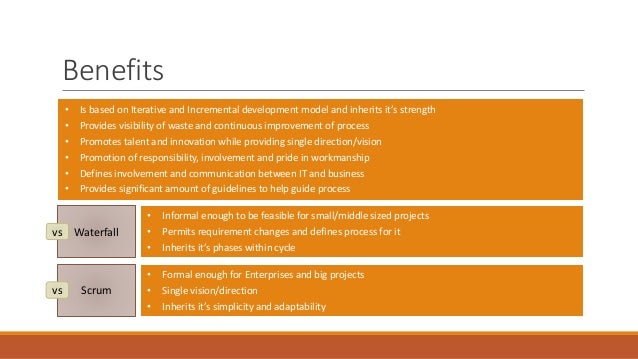Nov 10, 2017 The Kaizen approach is one such model used for software development and has actually originated from a philosophy which believes in overall development of people first. To put it simply, the Kaizen approach emphasizes on achieving continuous improvement by adding value to the organization and developing people. Kaizen 5S Applied to Software Development (And a Bit More) Go back to the roots of the kaizen methodology as created in the Toyota Production System and apply them to your workplace.
InfoQ HomepageNewsKaizen in Lean Software Development
Lean methods employ Kaizen, or continuous improvement, to reduce waste and improve results on a regular, even daily, basis. On the leanagilescrum group, Alan asked:
[A]re there known techniques for facilitating kaizen activities within Lean/Agile software development?
Martin suggested:
To me, software Kaizen is more than looking for waste, it's looking for ways you can improve things all across the board.

I'm a hands-on developer, so I'm pretty code-quality focused. If you have a horrible untested/untestable legacy codebase, it's pretty easy to measure the improvements you can make by refactoring to testability/design patterns. I guess you can look at that as reducing the wasted time people scratch their heads and say 'how's that supposed to work?'
I like to look things like number of classes under test, percentage of code coverage (although this is tricky by itself).
I strongly believe that if you don't have high quality code, you'll only be able to go so far with other Kaizen approaches.
Finally, Phillip responds with a detailed review of steps to follow before, after and during a Kaizen event, closing with:
The above described process should happen in less than a week. The spirit of Kaizen is to identify waste and eliminate it through process improvement, do so quickly involving the people actually doing the work, implement the change, support and monitor the change, then start all over again.
In a related blog post, Bruno Câmara analyzes the intersection between Scrum and Kaizen, suggesting that incremental improvements are made in the sprint retrospective, and that collecting and analyzing data is done daily with the burndown chart and project backlog. Broadening the scope somewhat, he suggests that that agile processes avoid waste through excess documentation, and that agile's small self-managed skilled teams push decision-making to the developers, as Kaizen intends.
For more information on Lean, Kaizen, Retrospectives and Continuous Improvement, read on at InfoQ.
Related Topics:
Related Editorial
What Are The Most Secure Programming Languages
Related Vendor Content
Related Sponsor
Kaizen Software Development Group
The InfoQ Newsletter
A round-up of last week’s content on InfoQ sent out every Tuesday. Join a community of over 250,000 senior developers. View an example
Kaizen Software Solutions
The Kaizen Manifesto
Re: The Kaizen Manifesto
Kaizen Software Development Plan

Your message is awaiting moderation. Thank you for participating in the discussion.
I'm inspired by the theory of constraint: en.wikipedia.org/wiki/Theory_of_constraints
And throughput accounting: en.wikipedia.org/wiki/Throughput_accounting
For me in software development you have to pull result out. Typically, if you don't test some aspect of an application you can't be sure if it works as expected. Hence you have to pull results out of the development process by testing.Your message is awaiting moderation. Thank you for participating in the discussion.
Kaizen is about micro improvements. Sprint Retrospective Cycles are too long to remember all the micro problems und potential micro improvements.
Creating an impediments backlog at the daily standups may help since the cycle is much shorter.
jeffsutherland.com/scrum/2006/06/why-three-ques...Your message is awaiting moderation. Thank you for participating in the discussion.
If you read Phillip's steps and you are in software development field you will notice it is hugely similar to the app profiling activity:
- observe and measure the app
- try out different approaches
- keep an eye on it
So, imo in this case Kaizen sounds like a development process profiling.
./alex
--
.w( the_mindstorm )p.
________________________
Alexandru Popescu
Senior Software Eng.
InfoQ TechLead&CoFounderYour message is awaiting moderation. Thank you for participating in the discussion.
Robert Hoekman has written the Kaizen Manifesto (www.kaizenmanifesto.org/) in which he suggests the principles of the kaizen manifesto are:
1. Make continuous improvements in every aspect of the business.
2. Actively pursue a superior, complete customer experience.
3. Continually improve designs, code, and processes.
4. Strive to increase agility (binshou) while reducing costs.
5. Use the Deming Cycle to minimize disruption from change.
6. Prevent errors (poka-yoke), in software and in business.
7. Respect people, leverage expertise, and trust staff.
8. Reward suggestions, improvements, and progress.
9. Always move forward.
Although I'm not sure I buy into his critique vis-a-vis agile and Kaizen (see derivadow.com/2007/03/07/maintaining-agility-an...)Your message is awaiting moderation. Thank you for participating in the discussion.
Robert Hoekman has written the Kaizen Manifesto
Aren't these just normal rules that any sane company is supposed to use?
bests,
./alex
--
.w( the_mindstorm )p.
________________________
Alexandru Popescu
Senior Software Eng.
InfoQ TechLead&CoFounderYour message is awaiting moderation. Thank you for participating in the discussion.
Alex wrote:
'Aren't these just normal rules that any sane company is supposed to use?'
lol - yes, one would hope, however we(organizations of people) can get so bogged down with process that we forget that what we do is really about delivering value and supporting our front line workers to deliver on that value. We get so busy with 'stuff' we forget to focus on analyzing and improving our 'value stream'
bests,
./alex
--
.w( the_mindstorm )p.
________________________
Alexandru Popescu
Senior Software Eng.
InfoQ TechLead&CoFounder